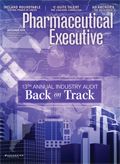13 Years Right
Pharmaceutical Executive
Pharm Exec's latest Industry Audit sticks to the series' longtime standard of emphasizing transparent indicators of shareholder value.
PHARM EXEC'S KEY FEATURE THIS MONTH IS THE ANNUAL INDUSTRY AUDIT—our thirteenth—on how well a cross section of companies in big Pharma, mid-tier specialty and biotech are delivering against today's hottest performance metric: shareholder value. When we began the series back in September 2002, this kind of broad indicator—indeed the very concept of "value"—was often discounted by the investment community in favor of the narrow, predictable balance sheet measures linked to generally accepted accounting and financial principles.

William Looney
Sentiment has changed, however, due to the failure of this approach to self-correct management hubris in taking unwarranted risks and papering over huge losses with shareholder money (remember Enron?) as well as increased government regulation and the subsequent rise of a stronger, more pluralist strain of shareholder activism. Hats off to our Audit partner, Professor Bill Trombetta of St. Joseph's University's Haub School of Business, for helping us pioneer this effort to insist that transparent indicators of value like brand loyalty, quality, and a customer-first orientation be placed at the center of the corporate decision chain. It certainly positioned the Pharm Exec editorial brand on the below side of history.

CAGR Averages (2009-2014)
The Audit is a self-renewing venture, with new elements added each year to ensure it remains relevant to current events. We have added to 2014 a new metric—Return on Invested Capital (ROIC)—to identify more precisely how companies perform in generating a profit on its capital investments, minus the costs of that capital, whether it is in the form of debt or stock. The metric opens for discussion whether management should be expected to at least cover the cost of invested capital—for example, are stock buyback programs a "free" expenditure? Can these, in some cases, actually help erode shareholder value? With this metric, it is possible to see precisely how a company share price can rise at the same time that shareholder value goes down. Using all nine metrics, author Trombetta also delivers an interesting assessment on long-term prospects for two key mergers: the pending pact between AbbVie and Shire, where their performances on each metric complement each other impressively, creating a union leading from strength to strength; and the still unresolved hostile bid by Valeant for Allergan, which adds up to a more muddled "odd couple" pairing.
Finally, this year's Audit takes advantage of its long, 13-year window to highlight the need to distinguish profit growth from increased revenues as the benchmark for evidencing true shareholder value. The table at right shows growth in profit versus growth in sales during the five years from 2009 to 2014, mediated by changes in Selling, General and Administration (SG&A) costs. The bottom line: the well managed company that delivers shareholder value will show profits growing faster than sales; when the reverse is the case, it indicates trouble in the form of pressures on price and gross margins as well as proliferating SG&A overhead. The star performers are our "stealth" players with the pedal to the metal against aging big Pharma—Novo Nordisk, Celgene, Allergan and, yes, Shire again—AbbVie must be smiling.

William Looney Editor-in-Chief wlooney@advanstar.com Follow Bill on Twitter: @BillPharmExec

Navigating Distrust: Pharma in the Age of Social Media
February 18th 2025Ian Baer, Founder and CEO of Sooth, discusses how the growing distrust in social media will impact industry marketing strategies and the relationships between pharmaceutical companies and the patients they aim to serve. He also explains dark social, how to combat misinformation, closing the trust gap, and more.